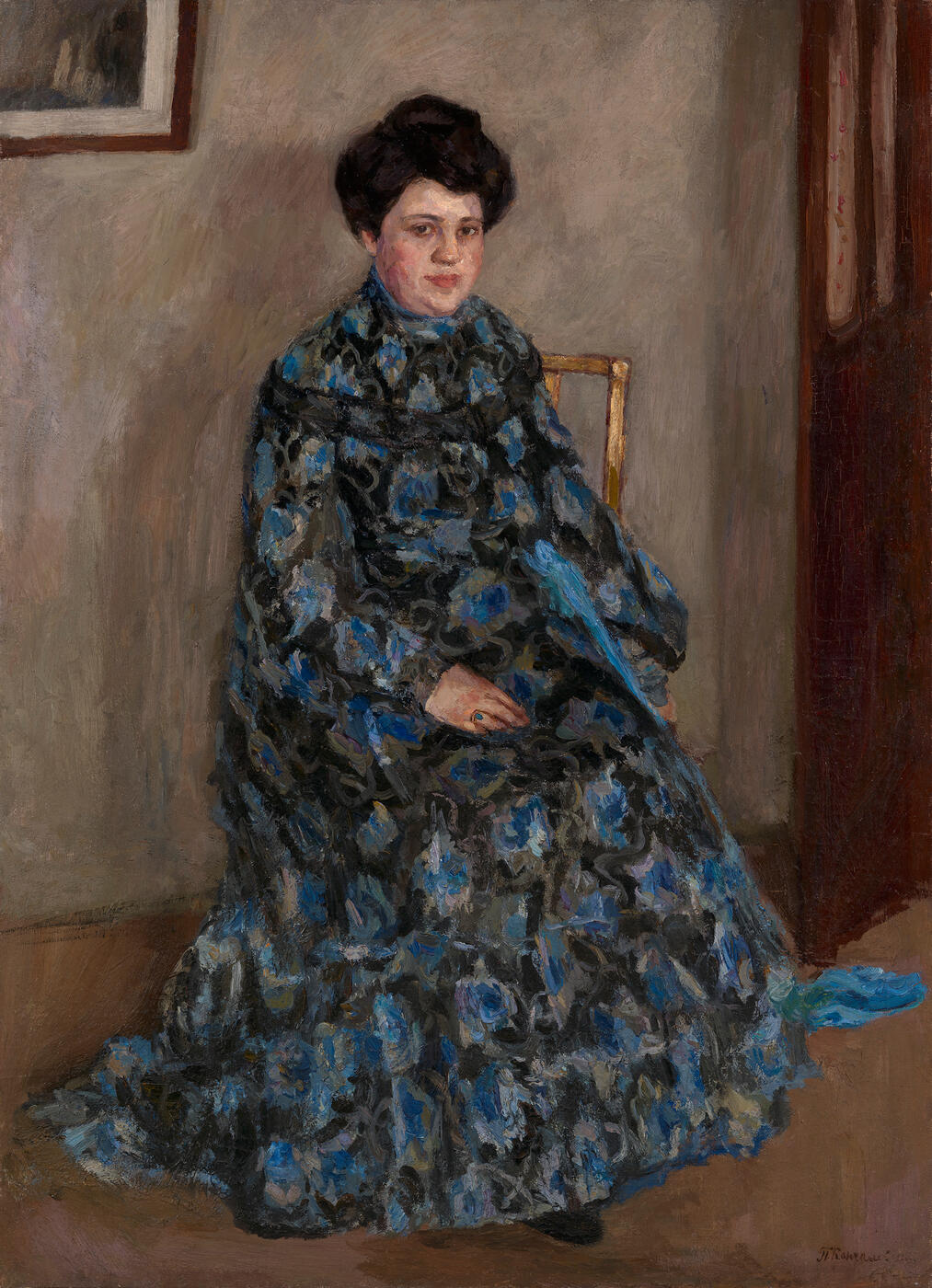5 June 2019 Important Russian Art Auctions, at Asia House
5 June 2019

* 60. KONCHALOVSKY, PETR (1876–1956)
Portrait of the Artist’s Wife, Olga Vasilievna Konchalovskaya, in Tulle Dress, signed.
Oil on canvas, 159 by 114.5 cm.
200,000–300,000 GBP
Provenance: Collection of the artist.
Thence by descent.
Acquired from Lavr Konchalovsky, the artist’s grandson, by a previous owner.
Private collection, Switzerland.
Authenticity certificate from the expert I. Gerashchenko.
Literature: V. Nikolskii, Petr Petrovich Konchalovsky, Moscow, Vsekokhudozhnik, 1936, p. 3, listed under the works from 1903; p. 32, mentioned in the text.
Konchalovsky. Khudozhestvennoe nasledie, Moscow, Iskusstvo, 1964, p. 90, listed as “zhi 14”.
I. Gerashchenko, “Konchalovsky Petr Petrovich. Portret zheny khudozhnika”, Antikvarnyi mir, No. 5, October 2012, pp. 123–125.
The Portrait of the Artist’s Wife, Olga Vasilyevna Konchalovskaya, in a Tulle Dress by Petr Konchalovsky, now presented for auction, is one of his extremely interesting early works. Created over several years that were crucial for establishing him as an artist, the portrait provides rare evidence of the intensive search that the future “avant-gardist” and one of the founders of the Jack of Diamonds association conducted in order to discover his own pictorial language.
In 1902, Konchalovsky married Olga Surikova, the daughter of his fellow artist, the celebrated Vasily Surikov. Konchalovsky had known her since his adolescent years. Brought up <…> constantly talking to her father about art, Olga was privy to all of his creative ideas and doubts and could not imagine a future outside painting. After the wedding in Moscow, the newlyweds departed for St Petersburg, where Konchalovsky had been studying at the Imperial Academy of Arts, and, in the autumn of that year, together with Surikov, they went off to Siberia, Surikov’s birthplace.
Konchalovsky brought back from that trip studies that were shown at an Academy exhibition, won general acclaim and received favourable reviews in the press. However, the artist himself was not satisfied with his achievements and decided to go to Rome, hoping to find inspiration from works of the great masters of the past. It was there, under the impact of Italian Renaissance and Baroque paintings, that Konchalovsky started work on his wife’s portrait. The family then moved on to Paris, where new artistic impressions forced Konchalovsky to reconsider his artistic approach and to reinterpret the concept of the work in an Impressionistic style. The result was that he moved away from classical examples and began to pursue his own path in art. Work on the portrait progressed slowly and, on returning to St Petersburg, the artist continued to labour over the composition.
During the following year, when Konchalovsky and his family decided once again to go to Rome, the unfinished portrait found itself in the Via del Babuino. According to the artist’s memoirs, the trip proved to be a failure as far as his work was concerned: “The studio was hired, the large portrait of my wife that I had begun was installed there, but I worked very unproductively.” (V. Nikolskii, Petr Petrovich Konchalovsky, Moscow, Vsekokhudozhnik, 1936, p. 32).
After the Rome sojourn, the portrait again visited Paris, to subsequently return once more to St Petersburg. In 1936, the artist’s biographer Viktor Nikolsky described what Konchalovsky had to say about the picture’s fate: “... he spent almost the whole winter painting in St Petersburg the huge portrait of his wife, started in Rome, but he never finished it … until his daughter Natasha’s nanny thought of taking ‘the lady’s portrait’ with her when leaving for the countryside” (V. Nikolskii, loc. cit.).
The portrait of Olga Konchalovskaya, extremely complex colouristically and imbued with a sincere admiration for the model, was a kind of summation of the years of intense creative search by a maverick young painter who at that time embraced a maximalist artistic stance. Subsequently, Konchalovsky’s wife recalled that the period from 1902 to 1908 had been very difficult for him, to the extent that he ruthlessly destroyed almost everything that he had created at that time. He did not even spare his own Academy competition picture, Fishermen Drawing in Their Nets, for which he gained official status of an artist in 1907.
This is why the Portrait of the Artist’s Wife, Olga Vasilyevna Konchalovskaya, in a Tulle Dress is not only one of Konchalovsky’s very rare surviving works from the early 1900s, recording the memory of the peaceful family happiness of the first years of his marriage. Moreover, it is the outcome of his many years of intense creative search, a unique example of the synthesis of academic training and the emerging personal view of a young artist who was discovering the possibilities of a “new art”.
Notes on symbols:
* Indicates 5% Import Duty Charge applies.
Ω Indicates 20% Import Duty Charge applies.
§ Indicates Artist's Resale Right applies.
† Indicates Standard VAT scheme applies, and the rate of 20% VAT will be charged on both hammer price and premium.